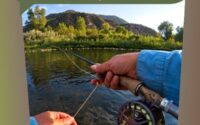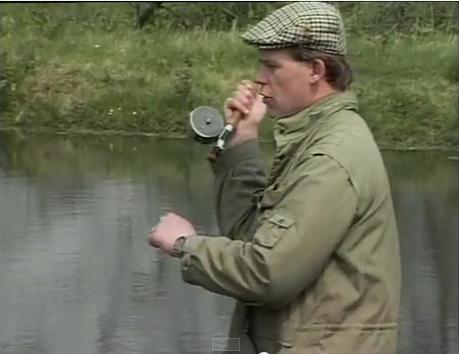| Disclosure: Just to be open and honest the buttons and links you click on in the website will in most cases take you to another website where you can purchase the products I am reviewing. As an Amazon Associate I earn from qualifying purchases. |
Distance Fly Casting Techniques

Do you struggle to get your flies out to trout that are showing just out of reach say about the 20-30 yard distance? If so you are not alone. I too was only able to make short casts that reached about twice the length of the rod away and struggled to get to those lying fish that always seemed to know where they were safe away from my reach. Well its not impossible to get your cast to reach 30 yards you just need to learn distance fly casting techniques.
There are four main things that will increase a fly casters distance.
1) Higher line trajectory
2) More speed in the fly line
3) Extending your stroke
4) Tighter loops
If we take these in order high line trajectory means stopping your rod as high as possible so the fly line has the time to fly forward before it loses speed and hits the water. To do this stop the rod sooner on the forward stroke resulting in a high line. When doing this the back cast needs to be slightly lower to allow the straight line 180 deg from back cast to forward cast. The straighter the better.
More speed in the fly cast requires a double haul being put into the fly cast along with accurate stops. When doing the hauls we need to extend our line hand as far as possible away from the rod hand to maximize the haul length. To really make that stop perfect a squeeze of the rod hand is required to maximize the power to flow from the rod to the fly line.
Extending the stroke means moving your rod hand further through the cast which is done by drifting the arm after the stops in both the backward cast and the forward cast. As the rod is stopped just reach further back called drift and again on the forward cast we reach forward after the stop. We can add extra distance by rocking our body on both back and forward during each stroke. This can add a few extra feet to the casting stroke and when done with timing and power will add extra speed to the stroke.
Tighter loops mean the fly line profile is minimized to push through the air better making it aerodynamic. To do this effectively you need to move the rod in a straight line as if painting the ceiling. The less of an arc you form with the rod the tighter the loop will be, the bigger the arc the wider the loop will be. Make sure to power stop the rod in both the forward and back cast to transfer the energy. Do these two things and you should have tighter loops.
So there you have it four distance fly casting techniques that will extend your fly casting in no time. Just remember Rome wasn’t built in a day you need to put in a bit of time and practice these concepts. Concentrate on one at a time practicing over and over, then when you have it do one of the other concepts until you can do all four on their own. Then its time to combine them to really see the line fly. In no time you will be able to cast 100ft like a pro. For more info watch this great video below by Leyland Fly Co



This is a very good video. I started to incorporate techniques described in the video, and it helped improve my distance. However, one thing confuses me. In portions of the video George casts with his right foot forward, and in other portions with his left foot forward. Being a right handed caster I always have my left foot forward to let me “open up” when casting. Is George putting his right foot forward on purpose, even though he is casting with his right hand?
Hey David a very good question. traditionally the orthodox position for fly casting is to have the same foot as your fly rod hand forward. This allows you to keep stability for the cast and stop you turning your body as your hip will not allow it.
This is good practice when learning to fly cast so you don’t start picking up bad habits. The path of the fly line should be as straight as possible as if painting a ceiling with a brush and if you are able to turn you will put curves into your casts that will hamper distance.
However the reverse stance allows you to open up the body a bit so you can rock your body and also you can watch the loop unfold behind you and time the forward stroke. This is useful in distance fly casting.
As with George you will see that he has perfect timing in both the forward and back stroke this along with the hauling processes his cast is making great distance with minimum effort.
There is a misconception that if you put more power into a cast it will go further but really each rod can take only a maximum effort and once passed it you will cause unwanted wobble and wiggle in the cast causing trailing loops and knots. It is more to do with perfect timing and working out the maximum speed the rod will allow without this unwanted side effect to perfect the distance cast.
I have watched anglers struggle with basic fly casting looking for distance trying too hard to force the line forward then be amazed when I asked them to slow done the power and make better stops and hey presto they were able to put 10 extra yards on a cast they otherwise thought impossible.
My advise David if you can afford it is to get in a couple of lessons with a reputable casting instructor it will save you time and effort in the long run and put to bed any bad habits you have already picked up.
Tight Lines!
Thank you very much for your help. I am pretty much strictly a river trout fisherman, but I am thinking about trying some salt water fishing. That is why I decided to try to increase my distance. I am probably already able to cast well enough for the fishing that I will do, but I would still like to improve. I can cast in the 90 to 95 foot range (measured on the ground with a tape measure), and can cast up to 80 feet with ease and accuracy. HOWEVER, I seem to be hitting a wall when trying to extend beyond 90 to 95 feet. One thing I just noticed about my casting is that I seem to be squeezing the rod to stop it, before I finish my hull!! I am finding it hard to correct this. I guess bad habits developed over 45 years are hard to break. It is hard to tell from videos, but am I correct to assume that the stop of the rod should come at the very end of the hull?
Thanks again for your help.
Hey David, there are two hauls in the distance fly fishing cast as you didn’t specify I will give you my advice for both.
On the lift from the water at the start of the cast both hands are together and as I lift the rod I separate my hands so the rod hand is going upwards behind me and the left hand is coming down putting speed into the line.
As I perform the top stop at 1-2 o’clock I then move the left hand allowing the line to travel through the rings and into the back cast.
Then I move both hands apart as I do the forward stroke with the rod putting more line speed into the fly line.
The way I do it both hands stop at roughly the same time as my right hand stops at about 2-3 o’clock in front of me my left hand is down by my side where I let the line go to shoot through the rings.
The more you practice the easier it gets. Its more about timing, tight loops and firm stops than power.
If you are achieving 80-95 feet you are doing well. I find that fly casting much further than that hinders your ability to fish the flies well. The more fly line on the water the less you feel the takes and you will loose more fish.
The thing to remember in shore fly fishing is the wind (unless you have a calm day), if you try shooting line 100-120 feet you will no doubt have problems with your leader getting wind knots and tangles.
So my advice is take the rod to the shore and try it out. If you are catching fish then its job done. If not then buy a kayak! 🙂
Let us know how you get on.
Mark,
Thank you very much for your help. I focused on your comments about “painting the ceiling” and slowing down. This helped me.
I appreciate that I do not want to use very long casts to catch fish. However I found that as I work to improve my distance, my shorter casts also improve.
Thanks again.
Dave
David as you know you get better with practice and its not always about distance, its about delivering a fly to a rising fish with accuracy and timing.
I occasionally will grab my rod and go to a field or piece of water where I’m not disturbing other fly anglers and practice casting different fly casts, using both my strong and weaker hand.
This post on practicing fly casting drills can be fun to do and will improve your short range accuracy which in turn will help with your overall distance fly casting.